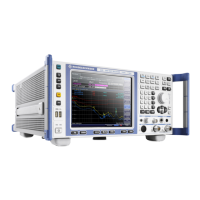Receiver Mode
R&S
®
ESR
213User Manual 1175.7068.02 ─ 12
Remote command:
CALCulate<n>:DLINe<k> on page 704
CALCulate<n>:DLINe<k>:STATe on page 704
Frequency Line 1 / Frequency Line 2 ← Display Lines
Enables or disables the frequency lines 1/2 (span > 0) and opens an edit dialog box to
enter the position of the lines.
For details see also Chapter 5.4.3.2, "Display Lines", on page 213 and Chap-
ter 5.4.3.4, "Working with Lines", on page 215.
Remote command:
CALCulate<n>:FLINe<k> on page 704
CALCulate<n>:FLINe<k>:STATe on page 705
Time Line 1 / Time Line 2 ← Display Lines
Enables or disables the time lines 1/2 (zero span) and opens an edit dialog box to
enter the position of the lines.
For details see also Chapter 5.4.3.2, "Display Lines", on page 213 and Chap-
ter 5.4.3.4, "Working with Lines", on page 215.
Note that time lines are only available in Spectrum mode.
Remote command:
CALCulate<n>:TLINe<Line> on page 861
CALCulate<n>:TLINe<Line>:STATe on page 861
Tuned Frequency (On Off) ← Display Lines
Turns a frequency line coupled to the receiver frequency on and off.
The line that marks the receiver frequency is a green line labeled "TF".
Available for the Scan result display.
Remote command:
CALCulate:TFLine:STATe on page 705
5.4.3.2 Display Lines
Display lines help to evaluate a trace – as do markers. The function of a display line is
comparable to that of a ruler that can be shifted on the trace in order to mark absolute
values. They are used exclusively to visually mark relevant frequencies or points in
time (span = 0), as well as constant level values. It is not possible to check automati-
cally whether the points are below or above the marked level values.
For details on setting and switching the display lines on/off see Chapter 5.4.3.4, "Work-
ing with Lines", on page 215.
Two different types of display lines are provided:
●
Two horizontal level lines for marking levels – Display Line 1 and 2
The level lines are continuous horizontal lines across the entire width of a diagram
and can be shifted in y direction.
●
Two vertical frequency or time lines for marking frequencies or points in time – Fre-
quency/Time Line 1 and 2
Common Analysis Functions

